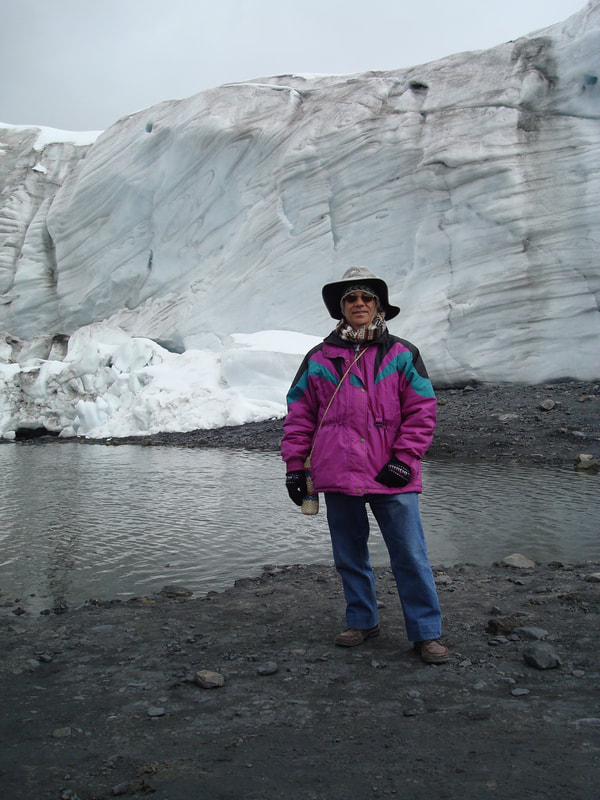Douglas Scott McGregor, Ph.D.
|
In the background is Pastoruri Glacier within Huascaran National Park in Peru (relatively close to Huaraz). The location is high, well over 16,000 feet. The air was very thin, and hiking up this high was slow. I had to stop about every 50 feet and rest just to catch my breath.
EDUCATION
Ph.D. - 1993, Nuclear Engineering, University of Michigan. M.S. - 1992, Nuclear Engineering, University of Michigan. M.S. - 1989, Electrical Engineering, Texas A&M University. B.S. - 1985, Electrical Engineering, Texas A&M University. EXPERIENCE / SKILLS
Radiation Detection Radiation Detector Design Solid State Physics Semiconductor Device Physics |
Prof. McGregor was born in Dallas, Texas in 1957. He received BA (1985) and MS (1989) degrees, both in electrical engineering, at Texas A&M University. He then received MS (1992) and PhD (1993) degrees, both in nuclear engineering, from the University of Michigan. From 1994 to 1996 he held a post-doctoral position at Sandia National Laboratory in Livermore, California before returning to the University of Michigan where he was an assistant research professor from 1997 to 2002. In 2002, he joined the Nuclear Engineering faculty at Kansas State University (KSU) where he now is a University Distinguished Professor and holds the Boyd D. Brainard Chair in Mechanical and Nuclear Engineering.
Prof. McGregor's research is focused on the design, development and deployment of novel radiation detectors and detector systems. In particular, he develops systems for measuring various ionizing and non-ionizing radiations based on semiconductor, scintillator, and gas-filled detectors. He specializes in semiconductor device physics, detector physics, semiconductor device designs, and fabrication of various semiconductor devices. Since coming to Kansas State University he and his students have created the Semiconductor Materials and Radiological Technology (SMART) Laboratory with over 9500 sq. ft. of laboratory space, including two clean rooms and a dry room. This facility for the fabrication of various radiation detectors is the largest at any US University. Prof. McGregor is recognized world-wide for inventing several novel radiation detectors; one of the most notable is his invention and development of microstructured semiconductor neutron detectors (MSND). These detectors have been ganged together to form an inexpensive replacement for the very expensive 3He gas tube detectors commonly used for neutron detection. Other notable inventions by McGregor include the Frisch collar/ring semiconductor gamma-ray spectrometer, the Li-foil gas-filled neutron detector, the radial fin gas-filled neutron detector, and the micro-pocket fission detector (MPFD). For his numerous inventions, he and his students have received 24 allowed patents. For these inventions and related research, Prof. McGregor has received the Sandia National Laboratory Research Excellence Award (1995), KSU Frankenhoff Research Excellence Award (2006), the KSU Engineering Distinguished Research Award (2016), the KSU Professorial Performance Award (2019), and five R&D 100 Awards (years 2005, 2009, 2014, 2015, and 2017). His book, Radiation Detection: Concepts, Methods, and Devices, co-authored by J. Kenneth Shultis, is a 1300 page comprehensive description of radiation detection and measurement. Additionally, he has published 9 book chapters on radiation detectors in various books, more than 140 peer reviewed journal articles and more than 100 conference proceedings, which, as of 2024, have resulted in over 7147 citations and an H-index of 41 and i10-index of 155 according to Google Scholar. He and his students have presented more than 140 talks at national/international conferences, universities, and workshops. Professor McGregor has directed the completion of 15 Ph.D. degrees and 15 Master's degrees. During the last 20 years, over 125 graduate and undergraduate students have received practical laboratory experience working in the SMART Laboratory. His undergraduate and graduate students working in his SMART Lab have won or shared in more than 45 awards and are highly sought after by national laboratories and industry. |
AWARDS / RECOGNITION
- Professorial Performance Award, Kansas State University – 2019.
- Research and Development 100 (R&D 100) Award – 2017; For the development of the “Wearable Detection Device (WDD)”.
- Engineering Distinguished Research Award, Kansas State University – 2016.
- Research and Development 100 (R&D 100) Award – 2015; For the development of “Antero/Shavano Neutron Spectrometer”.
- Boyd D. Brainard Departmental Faculty Chair in Mechanical and Nuclear Engineering at Kansas State University – 2015.
- University Distinguished Professor (Kansas State University) – 2015.
- Research and Development 100 (R&D 100) Award – 2014; For the development of “Li-Foil Neutron Detectors”.
- Kansas State University Making a Difference Award – 2010; For outstanding mentorship of women engineers.
- Research and Development 100 (R&D 100) Award – 2009; For the development of “Microstructured Neutron Detectors”.
- Kansas State University Dept. of Mechanical and Nuclear Engineering Graduate Advisor Award, 2008.
- Kansas State University Dept. of Mechanical and Nuclear Engineering Outstanding Advisor Award, 2008.
- Kansas State University College of Engineering Research Excellence Award – 2006; For innovative detector research in materials growth, detector design, and detector deployment.
- Research and Development 100 (R&D 100) Award – 2005; For the development of the “Frisch Collar High-Energy-Resolution Gamma-Ray Spectrometer”.
- Sandia National Laboratory Excellence Award – 1995; For the manufacture of innovative radiation detectors.
Curriculum Vitae
| cv-august-2022.pdf |
